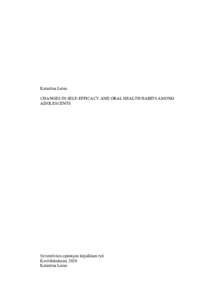Changes in self-efficacy and oral health habits among adolescents
Leino, Katariina (2020-05-22)
Changes in self-efficacy and oral health habits among adolescents
Leino, Katariina
(22.05.2020)
Julkaisu on tekijänoikeussäännösten alainen. Teosta voi lukea ja tulostaa henkilökohtaista käyttöä varten. Käyttö kaupallisiin tarkoituksiin on kielletty.
avoin
Julkaisun pysyvä osoite on:
https://urn.fi/URN:NBN:fi-fe2020061242903
https://urn.fi/URN:NBN:fi-fe2020061242903
Tiivistelmä
Objectives: The aim of this study was to examine whether there were associations between the simultaneous change in adolescents’ (aged 11-15 years) self-efficacy in relation to the change in tooth brushing frequency and xylitol use in a longitudinal setting.
Methods: This is a secondary analysis of a questionnaire data collected longitudinally 2001-2005 from adolescents of Pori, Finland aged 11-15 (n=1308). The associations between adolescents’ self-efficacy, tooth brushing frequency and xylitol use were measured using SPSS Statistics 25. The changes were reported by gender, parents’ education level and age group in a longitudinal setting. The variables were measured using multiple choice questions in three time points.
A literature review was conducted using PubMed- and Embase -databases. Self-efficacy, beliefs, oral health habits (tooth brushing and xylitol use) and parents’ education level were analysed statistically using Chi Square test and Mann Whitney U -tests to measure variables in different time points. For longitudinal evaluations Cochran’s Q test and Friedman’s test were used.
Results: Girls had higher self-efficacy than boys in all time points (p<0.001). The difference in self-efficacy between genders statistically significantly improves in every time point. In 2001 p<0.05, in 2003 p<0.05 and in 2005 p<0.001. Self-efficacy improved with age in all study groups. The biggest positive change in self-efficacy happened with adolescents aged 11-13 years when they decreased their tooth brushing frequency or xylitol use.
Conclusions: There was a slight association with the positive change in self-efficacy and decreasing of tooth brushing or xylitol use habit among adolescents.
Methods: This is a secondary analysis of a questionnaire data collected longitudinally 2001-2005 from adolescents of Pori, Finland aged 11-15 (n=1308). The associations between adolescents’ self-efficacy, tooth brushing frequency and xylitol use were measured using SPSS Statistics 25. The changes were reported by gender, parents’ education level and age group in a longitudinal setting. The variables were measured using multiple choice questions in three time points.
A literature review was conducted using PubMed- and Embase -databases. Self-efficacy, beliefs, oral health habits (tooth brushing and xylitol use) and parents’ education level were analysed statistically using Chi Square test and Mann Whitney U -tests to measure variables in different time points. For longitudinal evaluations Cochran’s Q test and Friedman’s test were used.
Results: Girls had higher self-efficacy than boys in all time points (p<0.001). The difference in self-efficacy between genders statistically significantly improves in every time point. In 2001 p<0.05, in 2003 p<0.05 and in 2005 p<0.001. Self-efficacy improved with age in all study groups. The biggest positive change in self-efficacy happened with adolescents aged 11-13 years when they decreased their tooth brushing frequency or xylitol use.
Conclusions: There was a slight association with the positive change in self-efficacy and decreasing of tooth brushing or xylitol use habit among adolescents.
